Welcome to Natural Wonders, where I investigate the questions that pop into my brain as I wander around the woods. Here in the Northern Hemisphere spring has definitely sprung, with pale green the new “it” color as trees model the latest fashions. Sap is flowing, flora and fauna are awakening, and everyone has the full-moon jitters. It’s spring, baby!
On a hike with friends yesterday, we came across this trail marker that has been chewed and scraped by some sort of animal – perhaps a squirrel? The question arose – why? Was it a squirrel? Does the paint taste especially delicious? Or do they need aluminum in their diet? Or is it an artistic protest statement by radicalized rodents about the intrusion of humans into the natural world?
Who’s been chewing this aluminum sign? And more importantly, why?

The culprit is squirrels.
Squirrels are rodents, just like mice, rats, beavers, nutria and 2,000 other species. Turns out that rodents are the LARGEST group of mammals and make up one-third of all mammals on earth. (Could that be because prolific mice and rats fall in this category?)
Rodents have upper and lower incisors, just like us, but interestingly their incisors don’t have roots and never stop growing. To keep their teeth under control, rodents have to keep their teeth ground down by chewing. Eating nuts or wood (like beavers) helps with this, but they also have to seek out hard non-food materials just to wear down their chompers.
The mutilated signs we found in the woods were likely squirrels scraping their teeth against the aluminum to grind their teeth to a manageable level. The yellow strip is left in the middle because their jaws will only open so wide. Some squirrels apparently have favorite locations for this, as apparent by the poor shape of this sign:
They’re not eating the aluminum, just grinding their teeth against it. And they’re not purposely eating the paint, though if it contained lead it would taste sweet and could be an attractant. However, I couldn’t find anything online to indicate the Forest Service uses lead-based paint on their trail blazes, and honestly, I’d be pretty disappointed if they did.
If squirrels don’t keep their incisors worn down, it can turn tragic for them:

This situation is called malocclusion and means the squirrel is no longer able to eat normally. It usually results in starvation, although sometimes the tooth can grow upward and embed itself into the squirrel’s face or eye. The solution – actually trimming the teeth with strong clippers or grinding them down with a handheld angle grinder – sounds cringeworthy, but rodent teeth don’t have nerves so it doesn’t hurt them.
In other news…
I wrote recently about losing both my mother and my dog on the same day. Getting out in the woods has helped me process my feelings, and not surprisingly, science supports the idea of nature as restoration.
Another source of healing has come from our adoption of another rescue dog. We didn’t expect to be ready for another pup so soon, but Toby’s story was simply too difficult to ignore. He’s a 14-month-old puppy who was neglected and starved by his previous owners.


The nonprofit shelter that took him in did an amazing job rehabilitating him since he is now 14 pounds heavier, shiny-coated and most importantly, loving and trusting of humans despite all evidence to the contrary. We are smitten with him and have already started taking him on hikes.



I share this to encourage folks to support the adoption of rescue animals and the amazing organizations that put so much energy and time into loving those who’ve been abandoned and mistreated.
Plant Highlight
I’m trying out a new segment about plants I find and what makes them special. Today: the ubiquitous violet, which most people can find in their yards or near roadsides. Did you know they’re edible? Andrew and I actually had them on our wedding cake many years ago – if you carefully paint the entire flower with egg white (use a tiny paint brush) and then sprinkle them with sugar, they harden up and become delicious, crystalized natural candy.
The leaves and flowers of violets contain vitamins A and C and can be added to salads or soups as garnish. They’re an early spring bloom and fairly easy to find. Just make sure you’re picking them from a clean area where no pesticides have been used and no pets have… regularly visited.




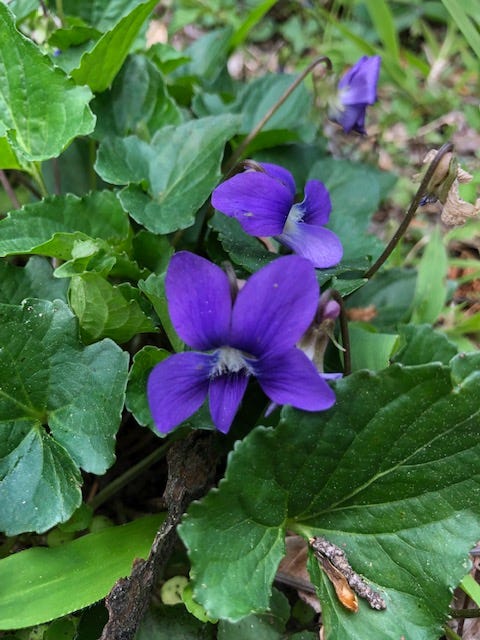



I've seen soap chewed by rats here in New Zealand but don't think we have any animals which chew metal signs. Fascinating.
Welcome, Toby 💛